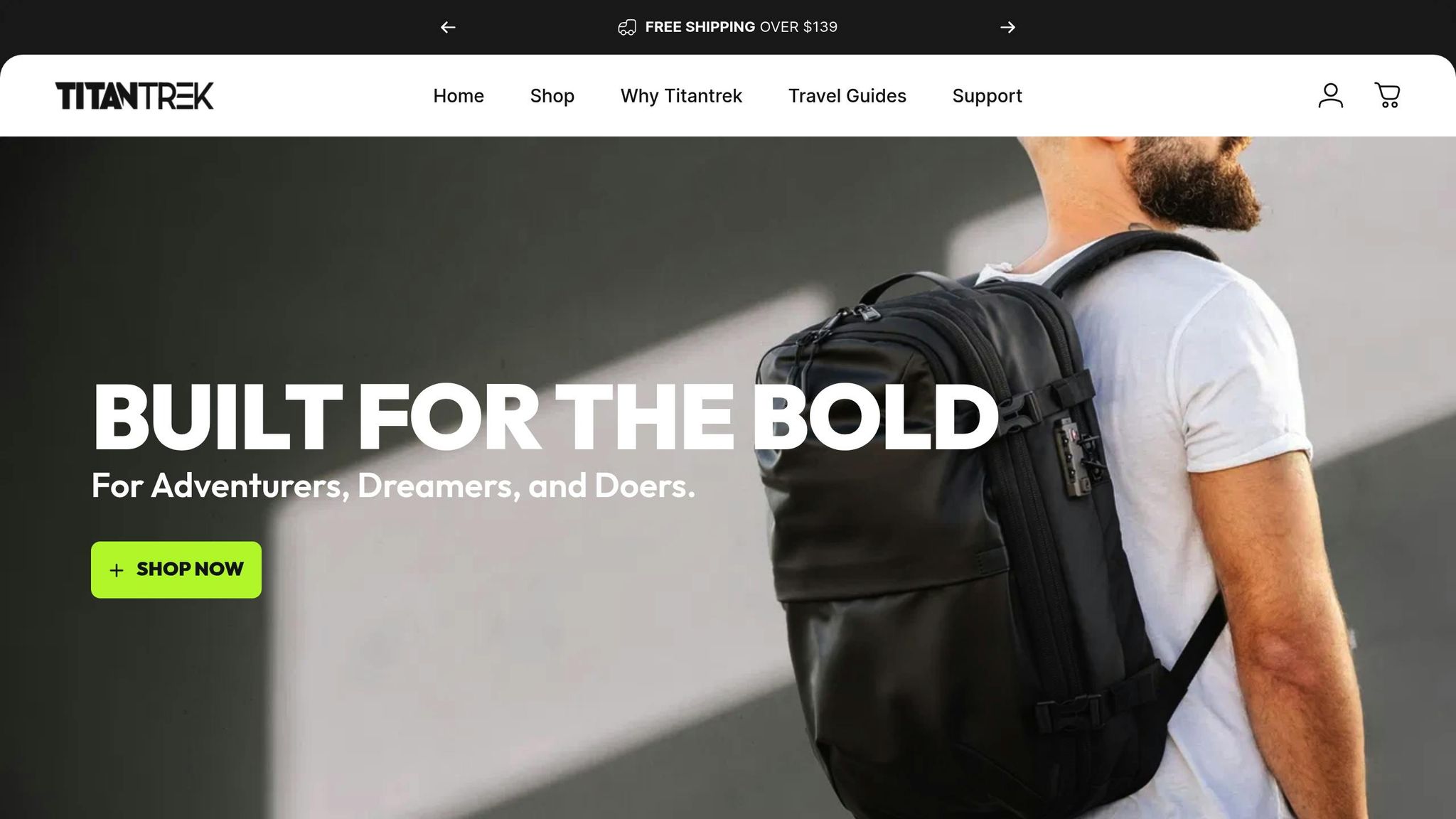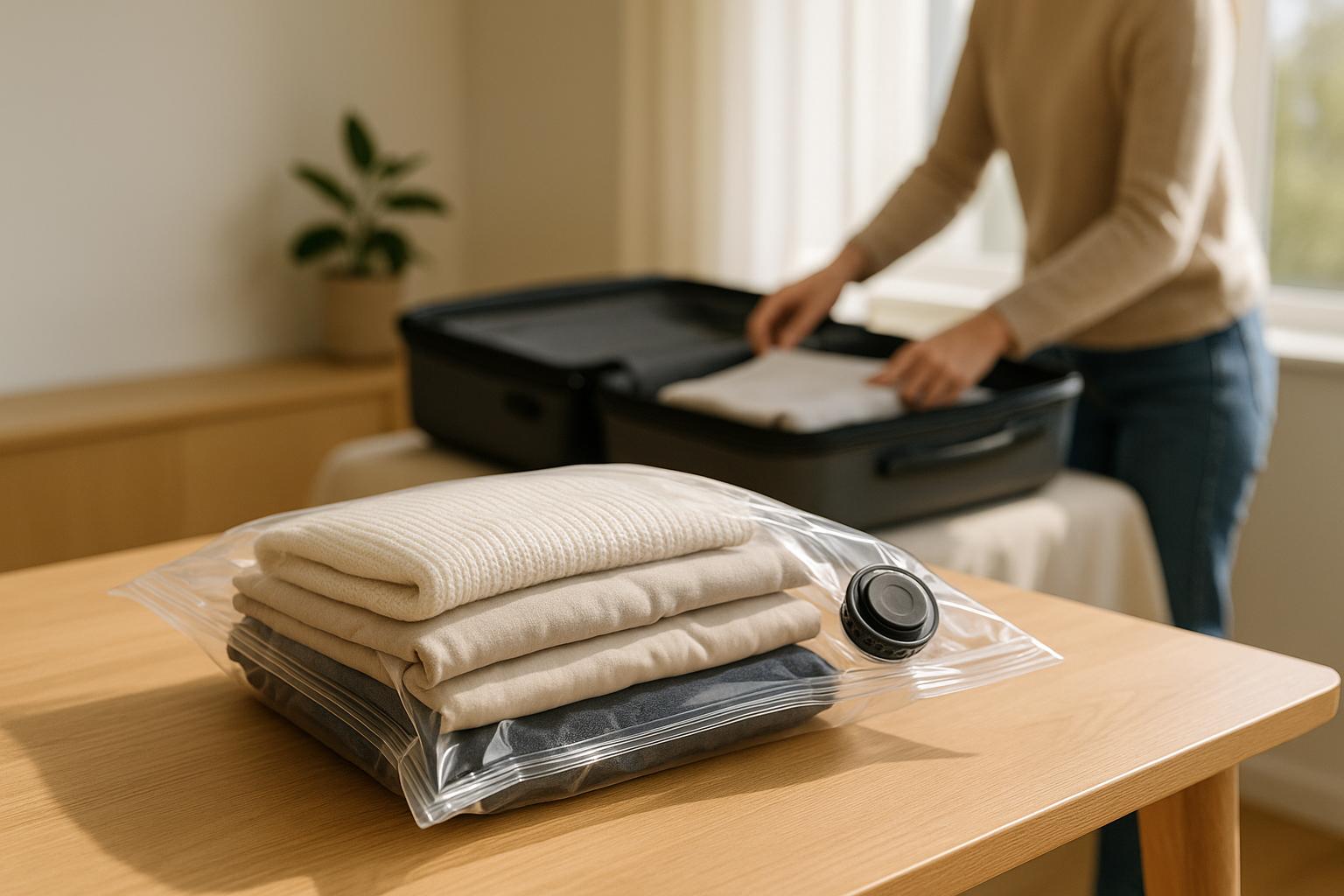Vacuum compression travel gear, like Titantrek's Atlas Vault, helps reduce carbon footprints by shrinking the size of packed items. This innovation not only saves space but also cuts emissions during manufacturing, shipping, and travel. Here's how it makes a difference:
- Less Material Use: Reduces raw materials needed for production.
- Efficient Shipping: Smaller, lighter packages mean fewer trips and lower fuel use.
- Eco-Friendly Design: Uses recycled, biodegradable materials and repairable parts.
- Lighter Travel: Compact luggage reduces fuel consumption during transit.
PACKING CUBES VS COMPRESSION BAGS | Pros and Cons
Problems with Standard Travel Gear Production
The way traditional travel gear is made often leads to excessive waste, particularly in packaging and materials. This not only increases the amount of trash that ends up in landfills but also raises the overall carbon footprint of the industry.
Excess Packaging and Materials
The travel gear industry has long relied on packaging practices that prioritize protection but often at the expense of sustainability. These practices commonly include:
- Layers upon layers of protective wrapping
- Plastic bags used for each individual component
- Oversized boxes filled with unnecessary filler material
- Non-biodegradable foam inserts
- Single-use plastic fasteners
These methods create a significant amount of waste, both during production and transportation. Reducing this waste is a key step toward lowering emissions and adopting cleaner, more efficient production processes.
How Vacuum Compression Cuts Carbon Emissions
Vacuum compression technology plays an important role in reducing carbon emissions. By cutting down on material use and energy demands during production, it directly addresses some of the environmental challenges associated with manufacturing.
Using Fewer Materials
Vacuum compression systems significantly lower the need for raw materials in producing travel gear. A great example is Titantrek's Atlas Vault, which features the "Double the Gear, Half the Space" technology. This approach enhances packing efficiency, reducing the overall material footprint.
Reducing Energy Use in Production
Beyond cutting back on materials, vacuum compression also helps streamline energy use during manufacturing. By compressing materials, the process requires less energy for heating and cooling, which directly translates to lower carbon emissions.
Supporting Sustainable Materials
In addition to saving on materials and energy, vacuum compression technology makes it easier to incorporate eco-friendly components. For instance, the Atlas Vault integrates recycled and biodegradable materials into its design, offering durability while being environmentally conscious. This commitment to sustainability is reflected in its strong customer feedback, earning a 4.88/5 rating from 25 reviews as of May 9, 2025.
Carbon Savings in Transport and Usage
Vacuum compression technology shrinks package sizes, allowing more items to fit into shipping containers or delivery vehicles. This means fewer trips are needed, cutting down on fuel consumption and making logistics more efficient. When combined with weight reduction, the shipping process becomes even more streamlined.
Lighter shipments use less fuel across all forms of transportation, from trucks to planes. The reduced weight creates a ripple effect, further lowering fuel use and amplifying the environmental benefits.
These practical efficiencies lead to noticeable reductions in carbon emissions. For example, Titantrek's Atlas Vault backpack incorporates a TSA-approved design that minimizes shipping volume without sacrificing functionality. Its thoughtful design not only enhances packing efficiency during distribution but also contributes to a measurable decrease in carbon emissions throughout its lifecycle.
sbb-itb-b1567d8
Long-Term Product Life Benefits
Investing in quality vacuum compression gear can make a big difference when it comes to reducing waste and protecting the planet. By extending the lifespan of products, these designs help cut down on waste and lower the overall carbon footprint over time.
Extended Product Lifespan
Using durable, waterproof materials and sturdy construction, vacuum compression gear is built to last. These features guard against moisture damage and wear, ensuring the gear stays functional for years. The result? Fewer items end up in landfills, and you get reliable performance that stands the test of time.
Repair-Friendly Design
One of the standout features of this gear is its focus on repairability. Instead of tossing out an entire product when something breaks, these designs allow for specific parts to be repaired or replaced. This approach not only saves money but also aligns with the goal of reducing waste and maximizing longevity.
Titantrek Atlas Vault Design

The Titantrek Atlas Vault backpack is a great example of how thoughtful design can prioritize both durability and sustainability. Built with top-notch materials and a strong vacuum compression system, it’s made to perform well over the long haul.
Here’s what makes the Atlas Vault stand out:
- TSA-approved locks for added security over time
- Waterproof and tough materials that resist wear and tear
- Ergonomic design for all-day comfort
Supporting Green Travel Habits
Vacuum compression gear has emerged as a practical tool for travelers looking to minimize their environmental footprint. By promoting smarter packing and more sustainable travel habits, these solutions help reduce waste and encourage eco-conscious choices.
Smarter Packing, Lighter Travel
Vacuum compression technology encourages travelers to pack lighter and more intentionally. By reducing the bulk of clothing and maximizing available space, this system naturally discourages overpacking. The result? Lighter luggage that not only makes travel easier but also reduces fuel consumption during transit.
Reducing Single-Use Waste
Traditional packing methods often rely on disposable compression bags or other single-use items, which eventually add to environmental waste. The Atlas Vault backpack eliminates the need for these wasteful products with its built-in vacuum compression system. Travelers can pack efficiently without turning to single-use solutions, aligning their habits with sustainable practices. The innovative design of the Atlas Vault backpack further enhances its eco-friendly appeal.
Practical and Sustainable: The Atlas Vault Backpack
The Atlas Vault backpack showcases how thoughtful design can make sustainable travel seamless. Travelers consistently praise its efficiency and ease of use, reflected in its impressive 4.88 out of 5 stars rating from 25 reviews. This feedback reinforces the idea that sustainability and convenience can go hand in hand. The backpack's design philosophy, summed up in the motto "Double the Gear, Half the Space", perfectly captures its user-focused approach [3][4].
Conclusion: Future Impact of Vacuum Compression
Vacuum compression technology is reshaping how we think about sustainability in travel gear. By significantly reducing the carbon footprint of products throughout their lifecycle, it’s not just a win for the environment but also for travelers seeking practicality and efficiency. Its clever design strikes a balance between meeting individual needs and pushing the boundaries of sustainable manufacturing and transportation.
Take the Atlas Vault backpack, for example - this product showcases how space efficiency and durability can go hand in hand. It’s a great example of how eco-conscious design doesn’t have to compromise on performance. Customers have noticed too:
"Amazing bag! So many compartments! The vacuum section works well and keeps suction and overall great build quality...This is a must have for any vacationer with a lot of gadgets and small items." – Val Hoeger [1]
Looking ahead, the evolution of vacuum compression technology promises even more impactful results. With advancements aimed at further reducing carbon emissions, this innovation is paving the way for a new era in travel gear. By combining smarter material use, improved shipping efficiency, and longer product lifespans, it’s setting the stage for a future where sustainability and functionality are inseparable.
FAQs
How does vacuum compression technology help reduce carbon emissions in travel gear production and use?
How Vacuum Compression Technology Lowers Carbon Emissions
Vacuum compression technology is changing the game when it comes to making travel gear more eco-friendly. By streamlining both production and usage, it helps cut down on carbon emissions in several ways.
During manufacturing, this technology reduces waste by using materials more efficiently. It minimizes excess fabric and unnecessary components, which not only saves resources but also lowers energy consumption. On top of that, products designed with vacuum compression can be shipped in smaller packages. This means fewer trucks, planes, or ships are needed to transport them, directly reducing transportation-related emissions.
When it comes to using these products, vacuum compression gear makes packing smarter and lighter. Travelers can fit more into less space, cutting down the need for extra luggage. This leads to lighter loads on airplanes, cars, and other transport methods, which can help reduce fuel consumption.
By blending smart design with eco-conscious practices, vacuum compression technology offers a practical way to travel lighter - both for you and the planet.
How does vacuum compression gear like the Atlas Vault help reduce environmental impact compared to traditional travel gear?
Vacuum compression gear, like the Atlas Vault, is a clever solution for reducing waste and energy use through smart design and material choices. Its compression system allows travelers to pack more efficiently, fitting more into less space. This means fewer bags are needed, which can help lower fuel consumption during travel.
On top of that, many of these products are made with durable, lightweight materials that are designed to last. These materials not only use fewer resources during production but also extend the product's lifespan, meaning replacements are needed less often. This thoughtful combination of efficiency and long-lasting materials plays a big role in cutting down carbon emissions from both manufacturing and day-to-day use.
How does vacuum compression technology in travel gear help promote eco-friendly travel and reduce environmental impact?
Vacuum compression technology in travel gear offers a smart way to pack more efficiently while reducing the environmental footprint of your trips. By compressing clothing and other items, this method helps you fit more into smaller bags, cutting down the need for oversized suitcases or extra luggage. This can translate to reduced energy and fuel consumption during transportation since lighter and less bulky luggage is easier to handle.
On top of that, travel gear designed with vacuum compression often incorporates durable, high-quality materials. This not only minimizes waste during manufacturing but also extends the life of the products, making them a solid investment for travelers who care about packing light and being eco-conscious.

Air New Zealand Baggage Rules: What Not to Pack
The Ultimate Guide to Using Your Titantrek Backpack